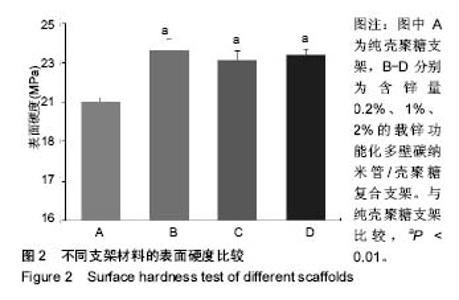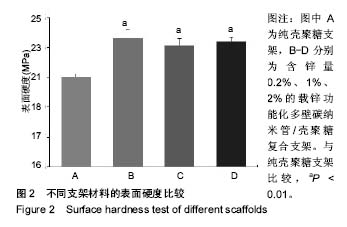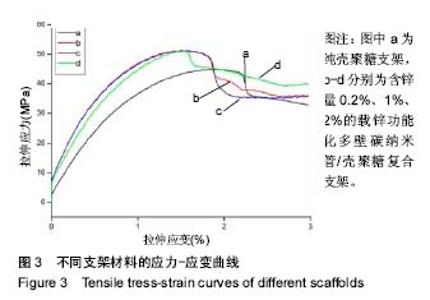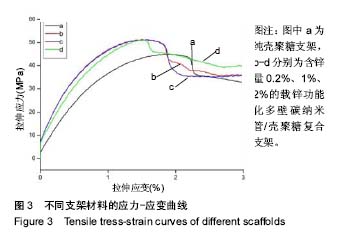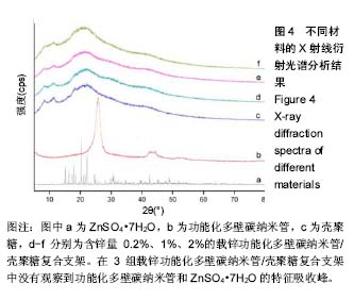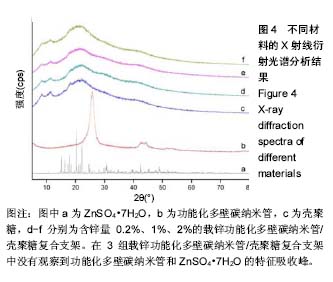Chinese Journal of Tissue Engineering Research ›› 2018, Vol. 22 ›› Issue (6): 889-895.doi: 10.3969/j.issn.2095-4344.0064
Previous Articles Next Articles
Preparation and performance properties of functionalized multi-walled carbon nanotubes/chitosan-zinc composite scaffolds
- 1Department of Stomatology, Shanxi Medical University, Taiyuan 030001, Shanxi Province, China; 2Institute of Coal Chemistry, Chinese Academy of Sciences, Taiyuan 030001, Shanxi Province, China
-
Received:2017-09-05Online:2018-02-28Published:2018-02-28 -
Contact:He Dong-ning, Associate professor, Department of Stomatology, Shanxi Medical University, Taiyuan 030001, Shanxi Province, China -
About author:Yang Ben, Studying for master’s degree, Department of Stomatology, Shanxi Medical University, Taiyuan 030001, Shanxi Province, China -
Supported by:the funded project of Shanxi Province Health and Family Planning Commission, No. 2015112
CLC Number:
Cite this article
Yang Ben, He Dong-ning, Qin Bo-heng, Zhang Bao-ping. Preparation and performance properties of functionalized multi-walled carbon nanotubes/chitosan-zinc composite scaffolds[J]. Chinese Journal of Tissue Engineering Research, 2018, 22(6): 889-895.
share this article
Add to citation manager EndNote|Reference Manager|ProCite|BibTeX|RefWorks
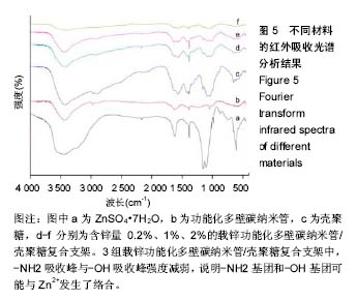
2.5 红外吸收光谱分析结果 功能化多壁碳纳米管在 1 635 cm-1附近的吸收峰对应-COOH基团,在3 446 cm-1附近的吸收峰对应-OH基团;壳聚糖在3 436 cm-1附近的吸收峰对应-OH基团,1 517 cm-1附近的吸收峰对应-NH2基团;-COOH吸收峰在功能化多壁碳纳米管/壳聚糖中没有出现,可能是功能化多壁碳纳米管的-COOH基团与壳聚糖的-NH2基团反应形成了新的酰胺键(CONH);3组载锌功能化多壁碳纳米管/壳聚糖复合支架中,-NH2吸收峰与-OH吸收峰强度减弱,说明-NH2基团和-OH基团可能与Zn2+发生了络合,载锌功能化多壁碳纳米管/壳聚糖复合支架支架各组分间实现了一定程度的化学结合,见图5。另外,载锌功能化多壁碳纳米管/壳聚糖复合支架在水中是稳定的,1个月的观察没有发现降解、分离和絮状沉淀。"
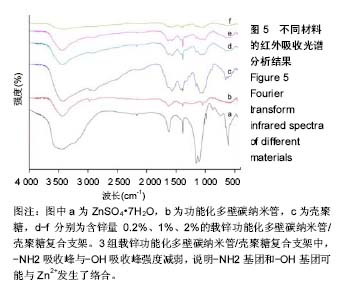
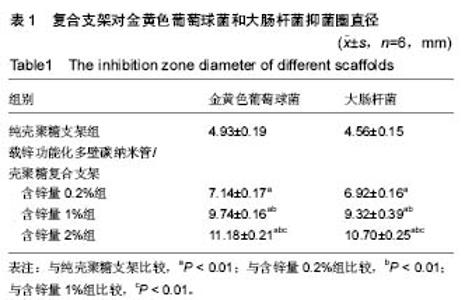
2.6 抑菌圈实验结果 与纯壳聚糖支架相比,3组载锌功能化多壁碳纳米管/壳聚糖复合支架对金黄色葡萄球菌抑菌圈直径增大(P < 0.01),说明载锌的复合支架对金黄色葡萄球菌具有更好的抑制作用,随着支架中锌含量的增加,复合支架对金黄色葡萄球菌的抑菌圈直径增大,组间两两比较差异有显著性意义(P < 0.01),说明随着支架中锌含量升高,复合支架的抗菌作用增强;与纯壳聚糖支架相比,3组载锌功能化多壁碳纳米管/壳聚糖复合支架对大肠杆菌的抑菌圈直径增大(P < 0.01),随着支架中锌含量增加,复合支架对大肠杆菌的抑菌圈直径增大,组间两两比较差异有显著性意义(P < 0.01),见表1,说明制备的载锌功能化多壁碳纳米管/壳聚糖复合支架对大肠杆菌具有一定的抗菌活性,随着支架中锌含量增加,复合支架对大肠杆菌的抗菌作用增强,说明实验制备的载锌功能化多壁碳纳米管/壳聚糖复合支架具有较好的抗菌性能。"
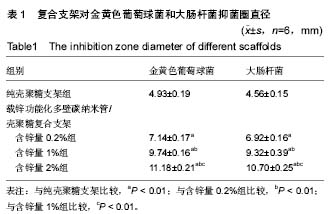
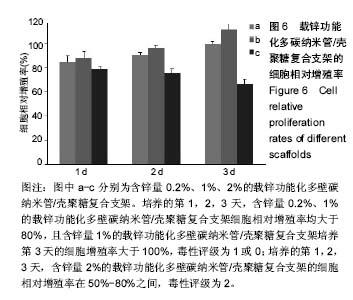
2.7 细胞毒性实验结果 培养的第1,2,3天,含锌量0.2%、1%的载锌功能化多壁碳纳米管/壳聚糖复合支架细胞相对增殖率均大于80%,且含锌量1%的载锌功能化多壁碳纳米管/壳聚糖复合支架培养第3天的细胞增殖率大于100%,毒性评级为1或0;培养的第1,2,3天,含锌量2%的载锌功能化多壁碳纳米管/壳聚糖复合支架的细胞相对增殖率在50%-80%之间,毒性评级为2,见图6。这说明制备的含锌量0.2%、1%的载锌功能化多壁碳纳米管/壳聚糖复合支架对成骨细胞无明显毒性,生物相容性良好,适合于成骨细胞的黏附与增殖;含锌量2%载锌功能化多碳纳米管/壳聚糖复合支架对成骨细胞有轻度毒性,可能与支架中锌含量过高有关。"
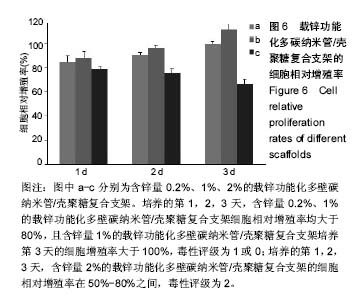
| [1]Delawi D,Kruyt MC,Huipin Y,et al.Comparing autograft, allograft, and tricalcium phosphate ceramic in a goat instrumented posterolateral fusion model. Tissue Eng Part C Methods. 2013; 19(11):821-828. [2]刘守应,王继芳,蔡谞.骨再生的研究进展[J].中国保健医学杂志,2014, 16(1):67-70.[3]杨毅,毕鑫,李多玉,等.人工骨材料修复骨缺损:多种复合后的生物学与力学特征[J].中国组织工程研究,2014,16(18):2582-2587.[4]Rezvani Z,Venugopal JR,Urbanska AM,et al.A bird's eye view on the use of electrospun nanofibrous scaffolds for bone tissue engineering: Current state-of-the-art, emerging directions and future trends.Nanomedicine. 2016;12(7):2181-2200. [5]夏琰,周潘宇,许硕贵.生物材料与支架在骨组织工程领域的研究进展[J].中华损伤与修复杂志(电子版),2012,7(5):516-519.[6]李吉鹏,邓国英,赵庆华.种子细胞-支架复合体在骨组织修复中的研究进展[J].中国矫形外科杂志,2012,20(20):1857-1860.[7]Billström GH,Blom AW,Larsson S,et al.Application of scaffolds for bone regeneration strategies: current trends and future directions. Injury.2013;44 Suppl 1:S28-33.[8]Kosuge D,Khan WS,Haddad B,et al.Biomaterials and scaffolds in bone and musculoskeletal engineering.Curr Stem Cell Res Ther. 2013;8(3):185-191.[9]Pighinelli L,Kucharska M.Chitosan-hydroxyapatite composites. Carbohydr Polym.2013;93(1):256-262.[10]Sowjanya JA,Singh J,Mohita T,et al.Biocomposite scaffolds containing chitosan/alginate/nano-silica for bone tissue engineering.Colloids SurfB Biointerfaces.2013;109:294-300.[11]Calderón L,Harris R,Cordoba-Diaz M,et al.Nano and microparticulate chitosan-based systems for antiviral topical delivery.Eur J Pharm Sci.2013;48(1-2):216-222.[12]Gao C,Cai Y,Kong X,et al.Development and characterization of injectable chitosan-based hydrogels containing dexame thasone/rhBMP-2 loaded hydroxyapatite nanoparticles.Mater Lett.2013;93(1):312-315.[13]Jiang T,Deng M,James R,et al.Micro-and nanofabrication of chitosan structures for regenerative engineering.Acta Biomater. 2014;10(4):1632-1645.[14]Edwards SL,Werkmeister JA,Ramshaw JA,et al.Carbon nanotubes in scaffolds for tissue engineering. Expert Rev Med Devices.2009;6(5):499-505.[15]Sahoo NG,Pan YZ,Li L,et al.Nanocomposites for bone tissue regeneration.Nanomedicine.2013;8(4):639-653.[16]Laurencin CT,Nukavarapu SP,Kumbar SG.Carbon nanotube composite scaffolds for bone tissue engineering :USA, US20090586345[P].2009-09-21.[17]Zdenko S,Dimitrios T,Konstantinos P,et al.Carbon nanotube-polymer composites: Chemistry,processing,mechanical and electrical properties.Prog Polym Sci.2010;35:357-401.[18]Abarrategi A,Gutiérrez MC,Moreno-Vicente C,et al.Multiwall carbon nanotube scaffolds for tissue engineering purposes. Biomaterials.2008;29(1):94-102.[19]Ji Z,Lin G,Lu Q,et al.Targeted therapy of SMMC-7721 liver cancer in vitro and in vivo with carbon nanotubes based drug delivery system.J Colloid Interface Sci.2012;365(1):143-149. [20]Ma Y,Zhou T,Zhao C.Preparation of chitosan-nylon-6 blended membranes containing silver ions as antibacterial materials. Carbohydr Res.2008;343(2):230-237.[21]王昕,张春丽,任广军,等.碳纳米管吸附去除水溶液中锌离子的性能[J].电镀与精饰,2008,30(10):4-6.[22]Hu H,Zhang W,Qiao Y,et al.Antibacterial activity and increased bone marrow stem cell functions of Zn-incorporated TiO2 coatings on titanium.Acta Biomater.2012;8(2):904-915.[23]Niranjan R,Koushik C,Saravanan S,et al.A novel injectable temperature-sensitive zinc doped chitosan/β-glycerophosphate hydrogel for bone tissue engineering.Int J Biol Macromol. 2013; 54:24-29.[24]Applerot G,Lipovsky A,Dror R,et al.Enhanced antibacterial activity of nanocrystalline ZnO due to increased ROS-mediated cell injury. Adv Funct Mater.2009;19:842-852.[25]Nagata M, Lönnerdal B.Role of zinc in cellular zinc trafficking and mineralization in a murine osteoblast-like cell line.J Nutr Biochem. 2011;22(2):172-178. [26]Qiao Y,Zhang W,Tian P,et al.Stimulation of bone growth following zinc incorporation into biomaterials.Biomaterials. 2014;35(25): 6882-6897.[27]袁景,甄平.骨组织工程支架的研究进展[J].医学综述, 2015,21(12): 2126-2130.[28]徐大朋,王绪凯.骨组织工程支架研究进展[J].中国实用口腔科杂志, 2014,7(3):177-181.[29]Jiang T,James R,Kumbar SG,et al.Chitosan as a biomaterial: structure,properties and applications in tissue engineering and drug delivery.Natural and Synthetic Biomedical Polymers.2014; 5:91-113.[30]Niranjan R,Koushik C,Saravanan S,et al.A novel injectable temperature-sensitive zinc doped chitosan/β-glycerophosphate hydrogel for bone tissue engineering.Int J Biol Macromol. 2013; 54:24-29.[31]Rodríguez-Vázquez M,Vega-Ruiz B,Ramos-Zúñiga R,et al.Chitosan and Its Potential Use as a Scaffold for Tissue Engineering in Regenerative Medicine.Biomed Res Int. 2015; 2015:821279.[32]年争好,孙凯,李瑞欣.组织工程骨研究背景与进展[J].中华损伤与修复杂志:电子版,2013,8(5):525-528.[33]Muzzarelli RA,Greco F,Busilacchi A,et al.Chitosan, hyaluronan and chondroitin sulfate in tissue engineering for cartilage regeneration: a review.Carbohydr Polym.2012;89(3):723-739.[34]赵易尔,金丹.壳聚糖复合材料在骨组织工程中的应用[J].基因组学与生物学,2015,34(4):842-848. [35]Zhang BG,Myers DE,Wallace GG,et al.Bioactive coatings for orthopaedic implants-recent trends in development of implant coatings.Int J Mol Sci.2014;15(7):11878-11921.[36]Puvaneswary S,Talebian S,Raghavendran HB,et al.Fabrication and in vitro biological activity of βTCP-Chitosan-Fucoidan composite for bone tissue engineering.Carbohydr Polym. 2015; 134:799-807. [37]Nanda Gopal Sahoo,Yong Zheng Pan,Lin Li,et al.Nanocomposites for bone tissue regeneration. Nanomedicine.2013;8(4):639-653.[38]Edwards SL,Werkmeister JA,Ramshaw JA,et al.Carbon nanotubes in scaffolds for tissue engineering. Expert Rev Med Devices.2009;6(5):499-505.[39]Pan L,Pei X,He R,et al.Multiwall carbon nanotubes/polycaprolactone composites for bone tissue engineering application.Colloids Surf B Biointerfaces. 2012;93:226-234.[40]Venkatesan J,Ryu B,Sudha PN,et al.Preparation and characterization of chitosan-carbon nanotube scaffolds for bone tissue engineering.Int J Biol Macromol.2012;50(2):393-402.[41]Aryaei A,Jayatissa AH,Jayasuriya AC.Mechanical and biological properties of chitosan/carbon nanotube nanocomposite films.J Biomed Mater Res A.2014;102(8):2704-2712. [42]欧阳明,丁纯梅,肖莎,等.壳聚糖及Zn2+模板壳聚糖膜与Zn2+螫合反应的动力学及机理探讨[J].化学世界,2006,47(7):388-394.[43]Ma Y,Zhou T,Zhao C.Preparation of chitosan-nylon-6 blended membranes containing silver ions as antibacterial materials. Carbohydr Res.2008;343(2):230-237.[44]李高青,桑青,崔凯.壳聚糖纳米银复合物基温敏水凝胶的抑菌性及细胞相容性研究[J].中国生化药物杂志,2016,36(6):63-66.[45]Swetha M,Sahithi K,Moorthi A,et al.Synthesis, Characterization, and Antimicrobial Activity of Nano-Hydroxyapatite-Zinc for Bone Tissue Engineering Applications.J Nanosci Nanotechnol. 2012; 12(1):167-172.[46]Tripathi A,Saravanan S,Pattnaik S,et al.Bio-composite scaffolds containing chitosan/nano-hydroxyapatite/ nano-copper-zinc for bone tissue engineering.Int J Biol Macromol.2012;50(1):294-299.[47]Jin G,Cao H,Qiao Y,et al.Osteogenic activity and antibacterial effect of zinc ion implanted titanium.Colloids Surf B Biointerfaces. 2014;117:158-165. [48]Qiao Y,Zhang W,Tian P,et al.Stimulation of bone growth following zinc incorporation into biomaterials.Biomaterials. 2014;35(25): 6882-6897.[49]余增丽,李云,郑艾.锌对体外培养小鼠胎鼠前肢骨发育的影响[J].中华预防医学杂志,2002,36(2):97-99.[50]马丽英,李灵芝,李云,等.锌缺乏和过量对小鼠胚胎体外骨形成的影响[J].营养学报,2000,22(1):18-21. |
| [1] | Zhang Tongtong, Wang Zhonghua, Wen Jie, Song Yuxin, Liu Lin. Application of three-dimensional printing model in surgical resection and reconstruction of cervical tumor [J]. Chinese Journal of Tissue Engineering Research, 2021, 25(9): 1335-1339. |
| [2] | Zeng Yanhua, Hao Yanlei. In vitro culture and purification of Schwann cells: a systematic review [J]. Chinese Journal of Tissue Engineering Research, 2021, 25(7): 1135-1141. |
| [3] | Xu Dongzi, Zhang Ting, Ouyang Zhaolian. The global competitive situation of cardiac tissue engineering based on patent analysis [J]. Chinese Journal of Tissue Engineering Research, 2021, 25(5): 807-812. |
| [4] | Wu Zijian, Hu Zhaoduan, Xie Youqiong, Wang Feng, Li Jia, Li Bocun, Cai Guowei, Peng Rui. Three-dimensional printing technology and bone tissue engineering research: literature metrology and visual analysis of research hotspots [J]. Chinese Journal of Tissue Engineering Research, 2021, 25(4): 564-569. |
| [5] | Li Li, Ma Li. Immobilization of lactase on magnetic chitosan microspheres and its effect on enzymatic properties [J]. Chinese Journal of Tissue Engineering Research, 2021, 25(4): 576-581. |
| [6] | Chang Wenliao, Zhao Jie, Sun Xiaoliang, Wang Kun, Wu Guofeng, Zhou Jian, Li Shuxiang, Sun Han. Material selection, theoretical design and biomimetic function of artificial periosteum [J]. Chinese Journal of Tissue Engineering Research, 2021, 25(4): 600-606. |
| [7] | Liu Fei, Cui Yutao, Liu He. Advantages and problems of local antibiotic delivery system in the treatment of osteomyelitis [J]. Chinese Journal of Tissue Engineering Research, 2021, 25(4): 614-620. |
| [8] | Li Xiaozhuang, Duan Hao, Wang Weizhou, Tang Zhihong, Wang Yanghao, He Fei. Application of bone tissue engineering materials in the treatment of bone defect diseases in vivo [J]. Chinese Journal of Tissue Engineering Research, 2021, 25(4): 626-631. |
| [9] | Zhang Zhenkun, Li Zhe, Li Ya, Wang Yingying, Wang Yaping, Zhou Xinkui, Ma Shanshan, Guan Fangxia. Application of alginate based hydrogels/dressings in wound healing: sustained, dynamic and sequential release [J]. Chinese Journal of Tissue Engineering Research, 2021, 25(4): 638-643. |
| [10] | Chen Jiana, Qiu Yanling, Nie Minhai, Liu Xuqian. Tissue engineering scaffolds in repairing oral and maxillofacial soft tissue defects [J]. Chinese Journal of Tissue Engineering Research, 2021, 25(4): 644-650. |
| [11] | Xing Hao, Zhang Yonghong, Wang Dong. Advantages and disadvantages of repairing large-segment bone defect [J]. Chinese Journal of Tissue Engineering Research, 2021, 25(3): 426-430. |
| [12] | Chen Siqi, Xian Debin, Xu Rongsheng, Qin Zhongjie, Zhang Lei, Xia Delin. Effects of bone marrow mesenchymal stem cells and human umbilical vein endothelial cells combined with hydroxyapatite-tricalcium phosphate scaffolds on early angiogenesis in skull defect repair in rats [J]. Chinese Journal of Tissue Engineering Research, 2021, 25(22): 3458-3465. |
| [13] | Wang Hao, Chen Mingxue, Li Junkang, Luo Xujiang, Peng Liqing, Li Huo, Huang Bo, Tian Guangzhao, Liu Shuyun, Sui Xiang, Huang Jingxiang, Guo Quanyi, Lu Xiaobo. Decellularized porcine skin matrix for tissue-engineered meniscus scaffold [J]. Chinese Journal of Tissue Engineering Research, 2021, 25(22): 3473-3478. |
| [14] | Mo Jianling, He Shaoru, Feng Bowen, Jian Minqiao, Zhang Xiaohui, Liu Caisheng, Liang Yijing, Liu Yumei, Chen Liang, Zhou Haiyu, Liu Yanhui. Forming prevascularized cell sheets and the expression of angiogenesis-related factors [J]. Chinese Journal of Tissue Engineering Research, 2021, 25(22): 3479-3486. |
| [15] | Li Xinping, Cui Qiuju, Zeng Shuguang, Ran Gaoying, Zhang Zhaoqiang, Liu Xianwen, Fang Wei, Xu Shuaimei. Effect of modification of β-tricalcium phosphate/chitosan hydrogel on growth and mineralization of dental pulp stem cells [J]. Chinese Journal of Tissue Engineering Research, 2021, 25(22): 3493-3499. |
| Viewed | ||||||
|
Full text |
|
|||||
|
Abstract |
|
|||||


